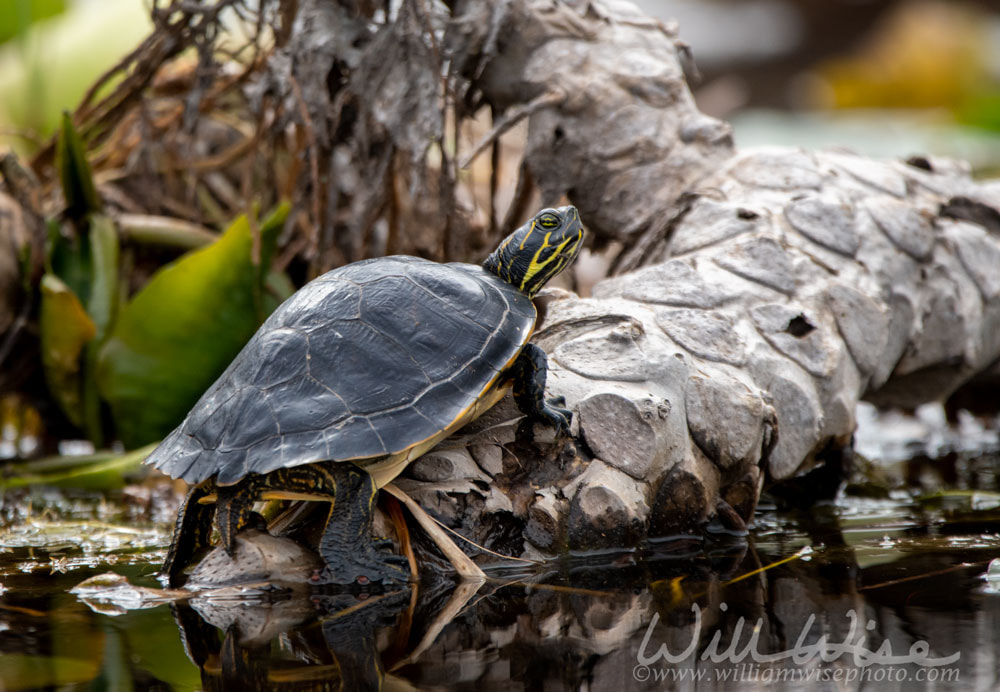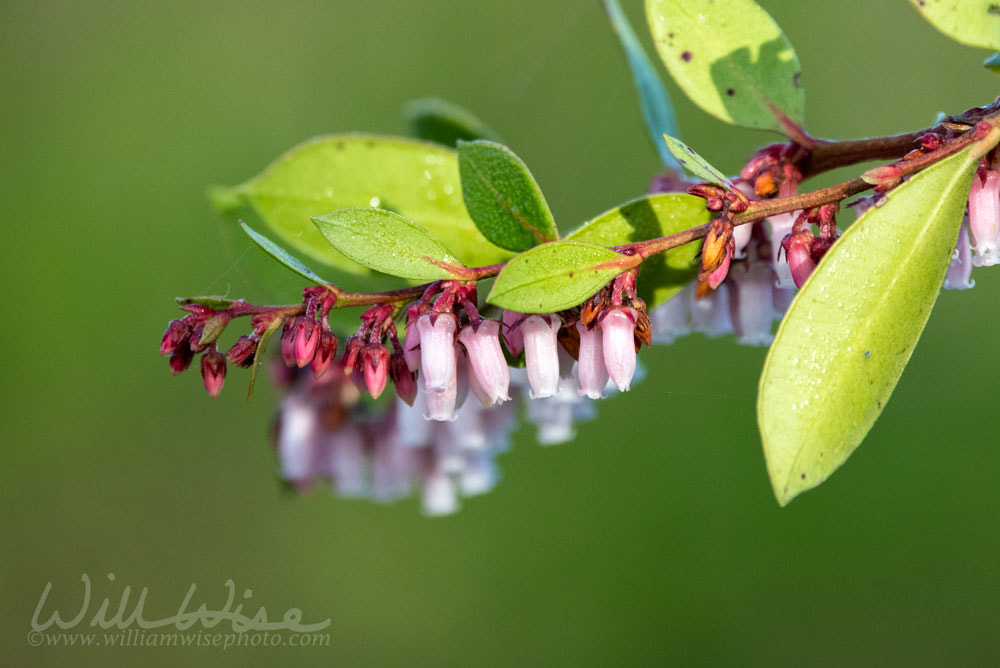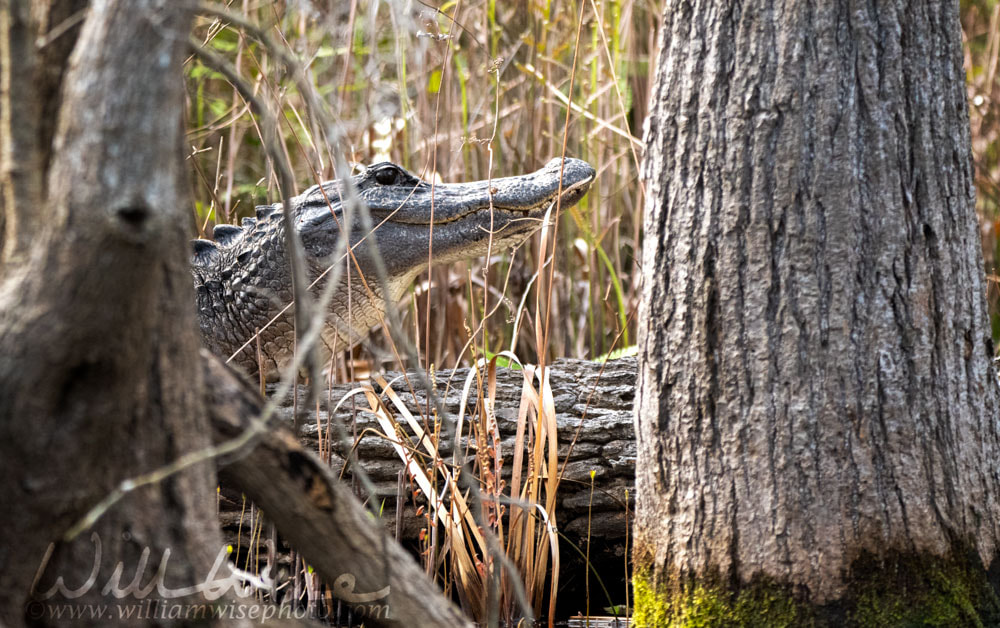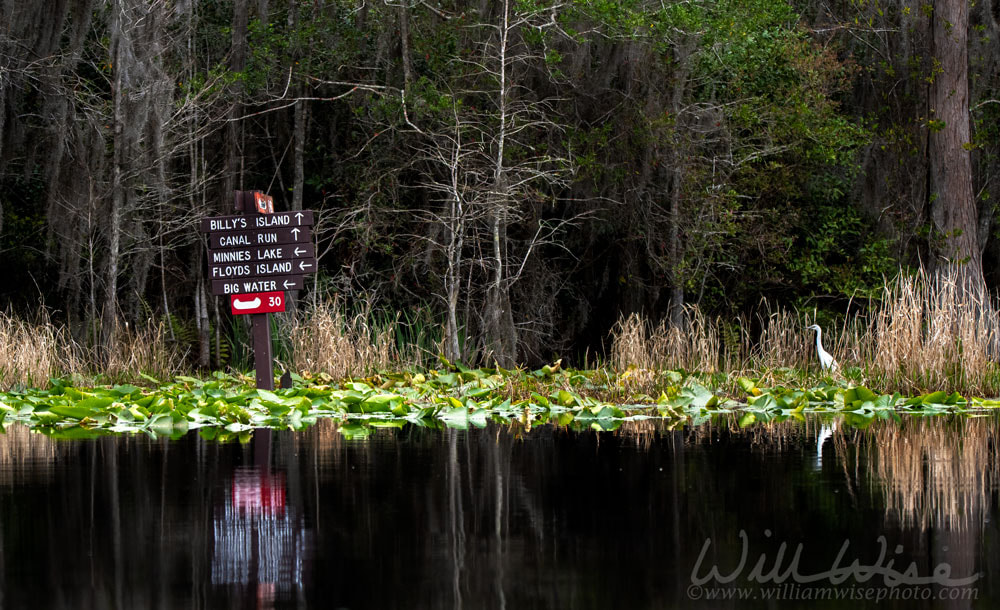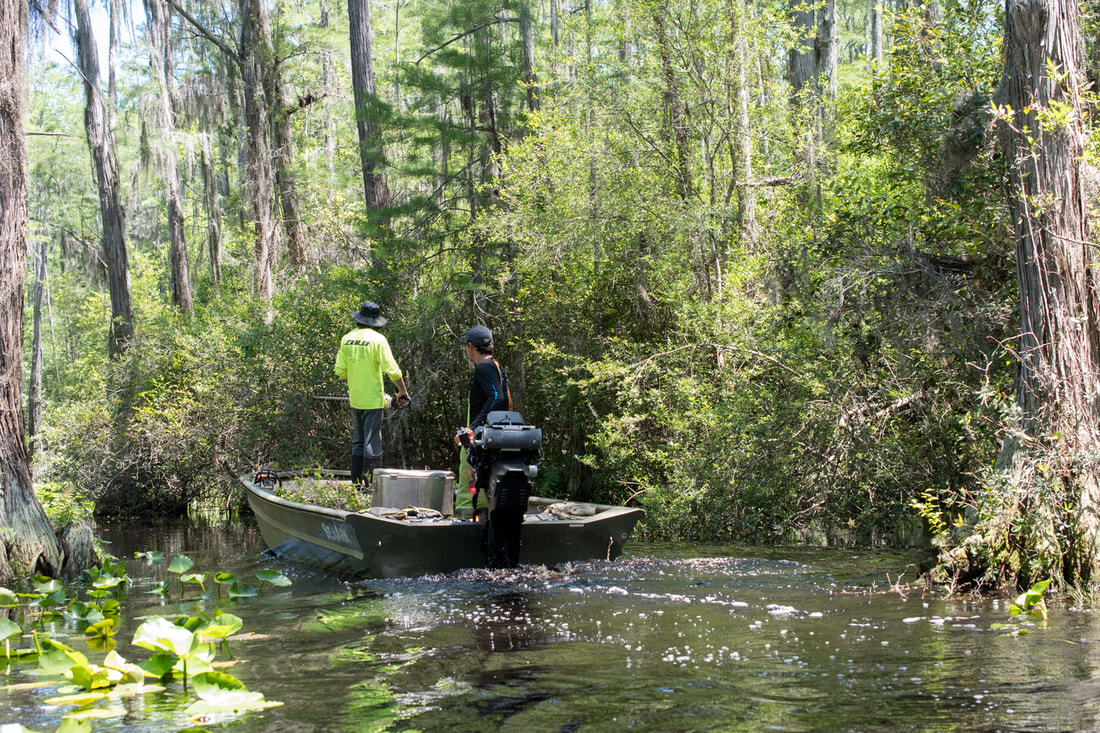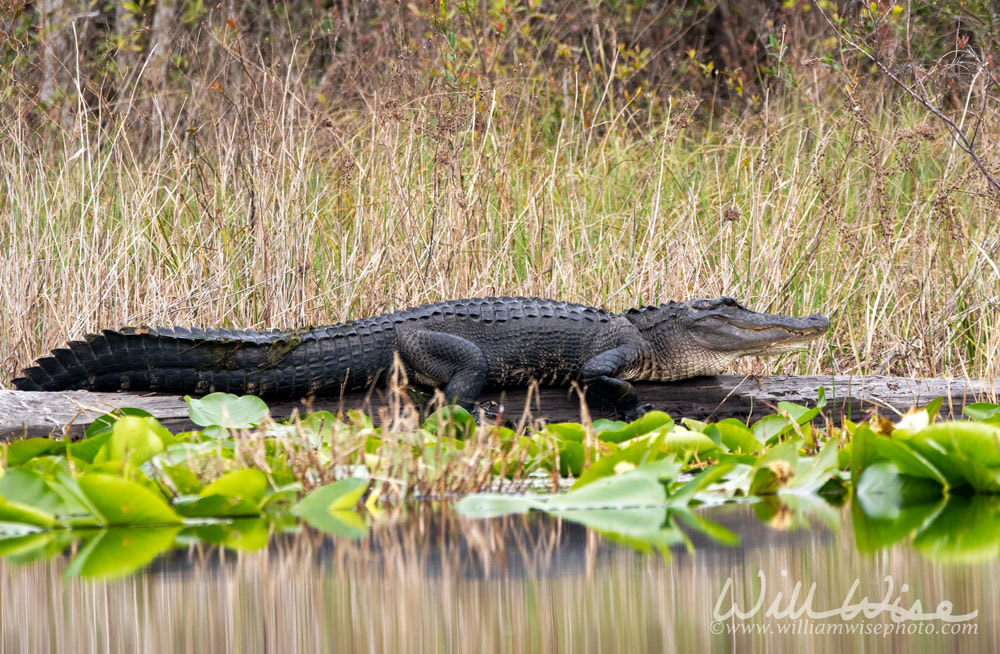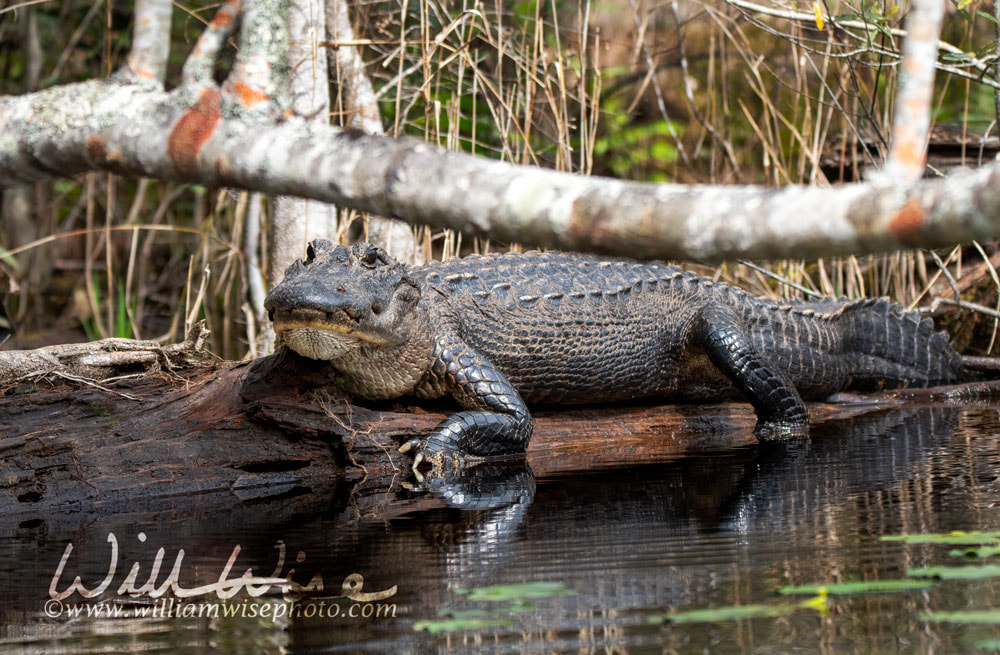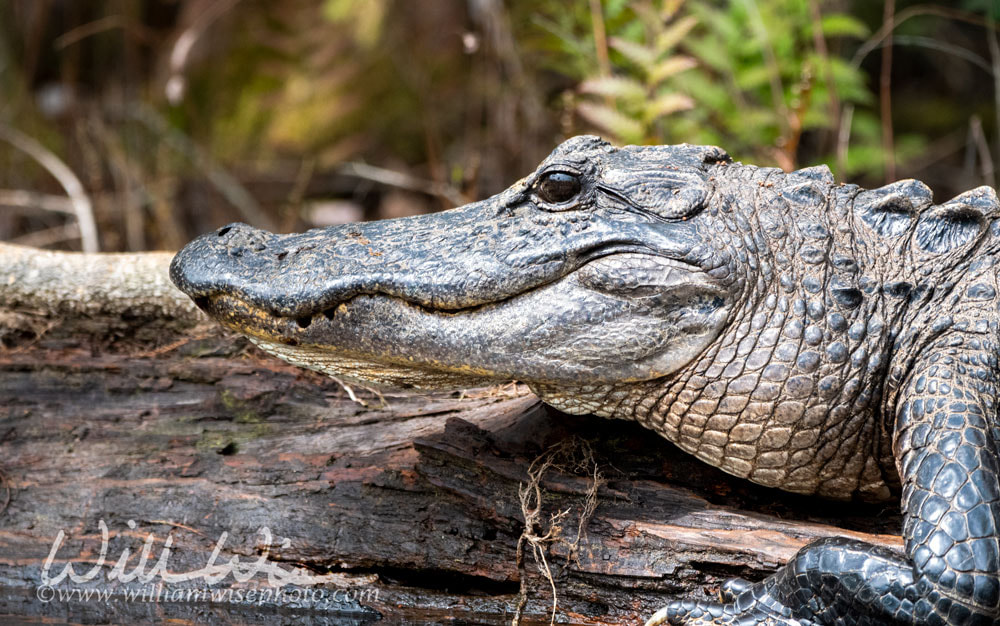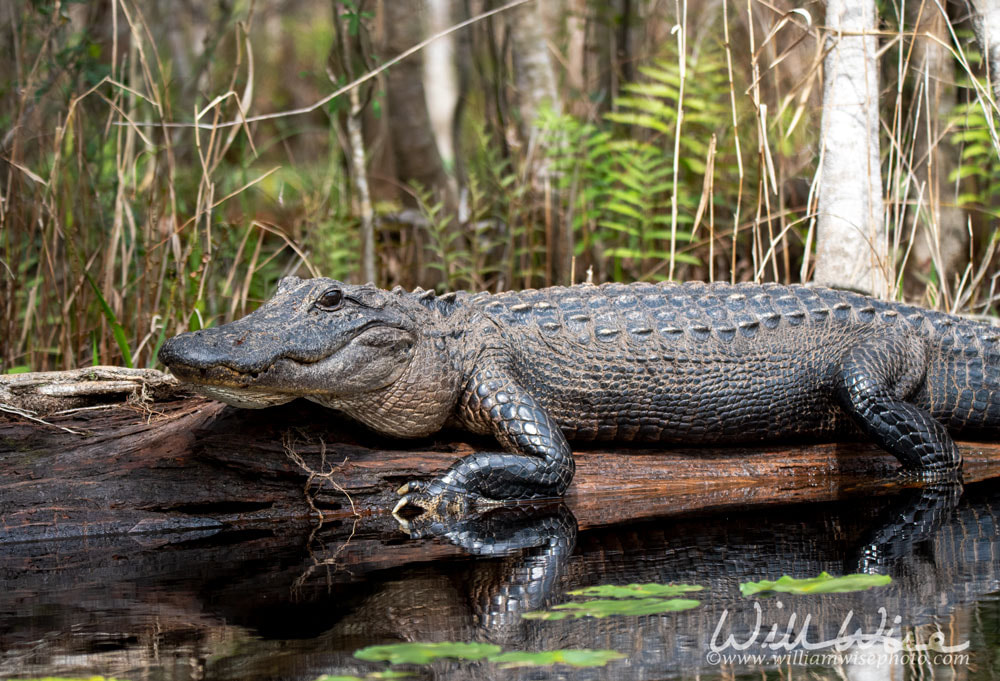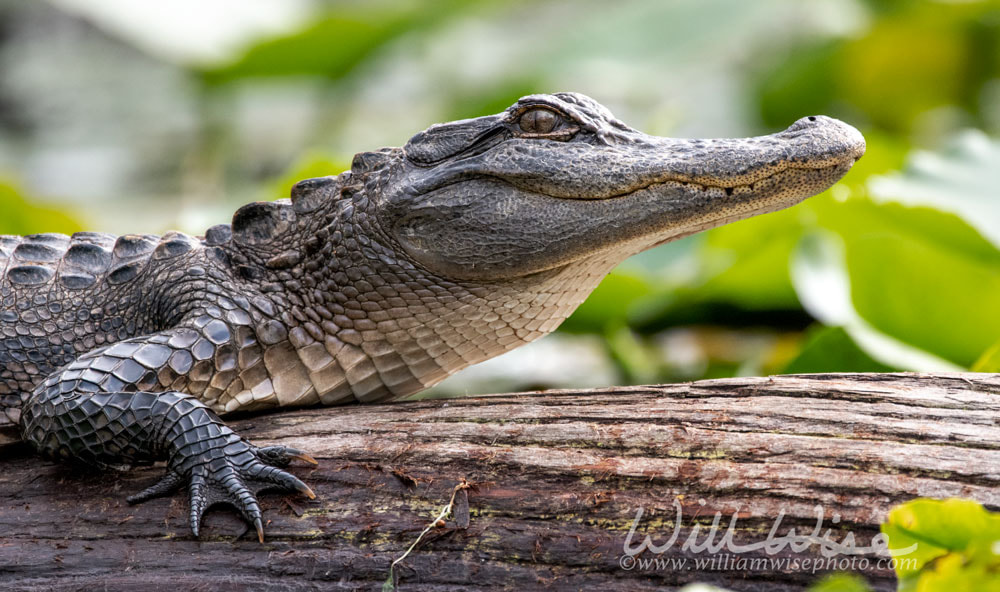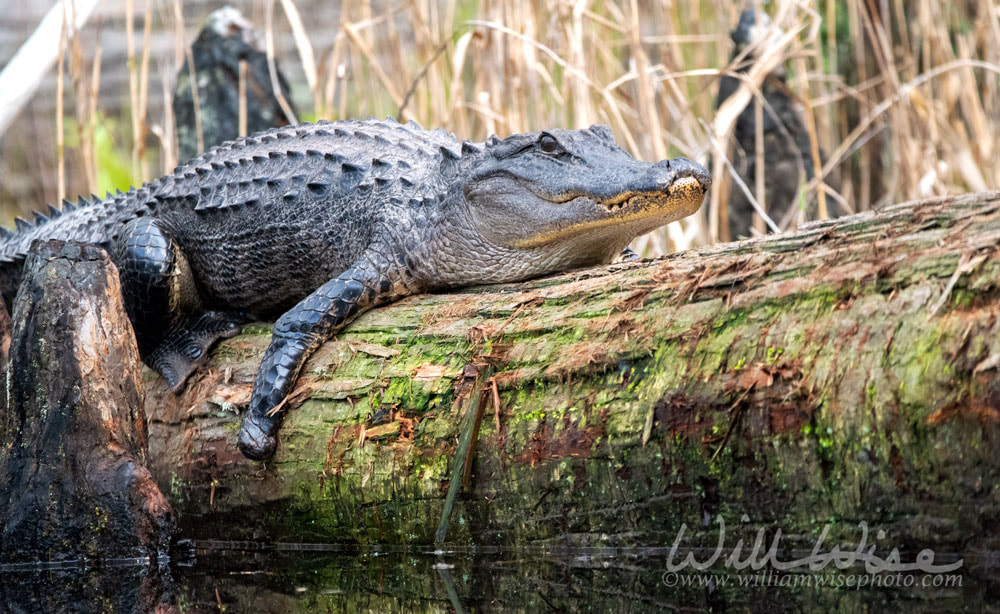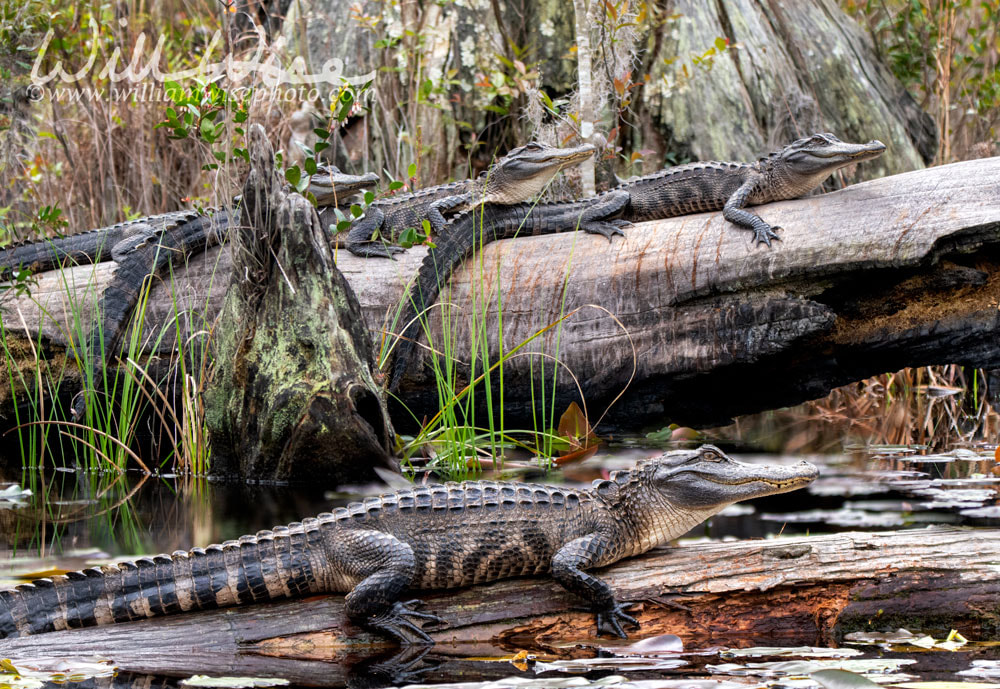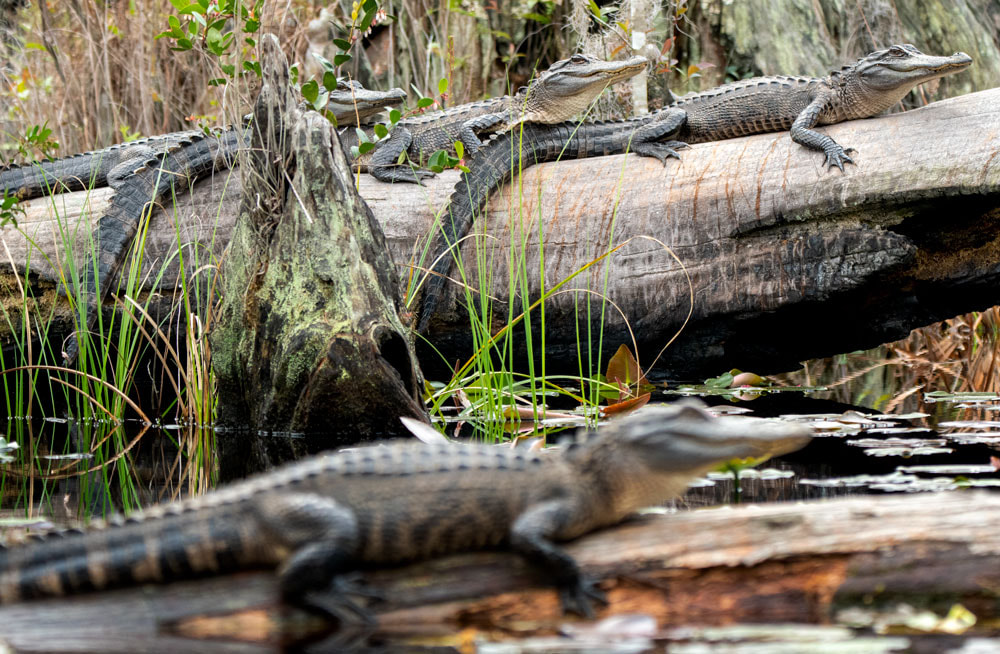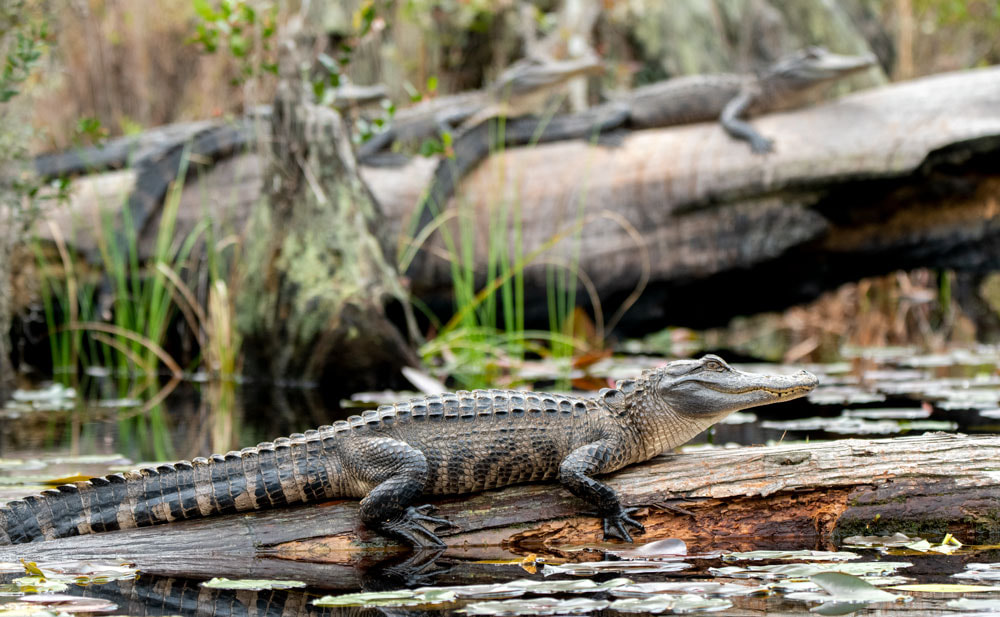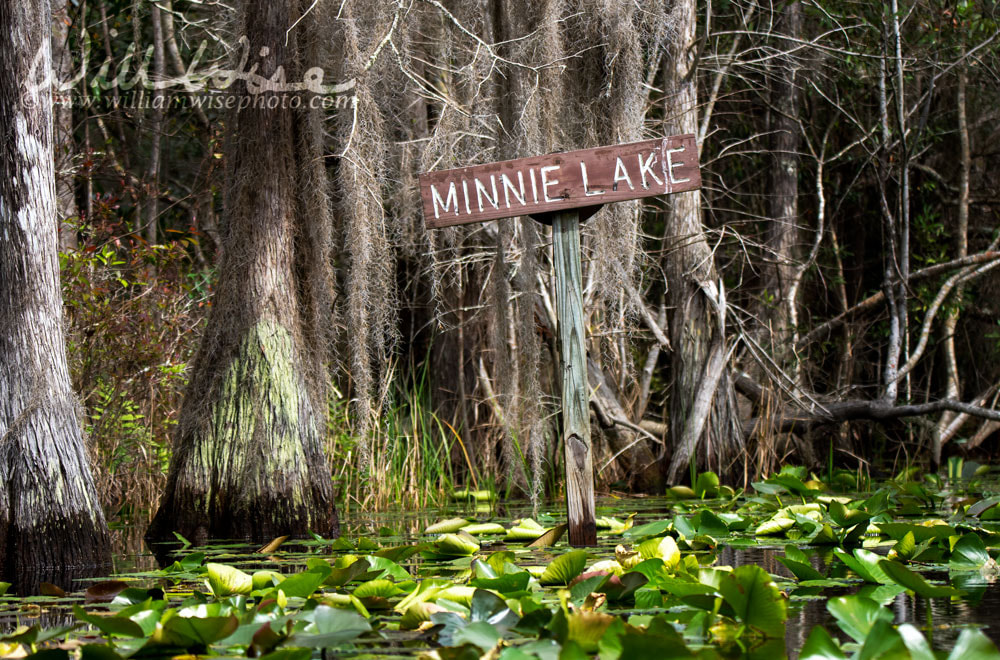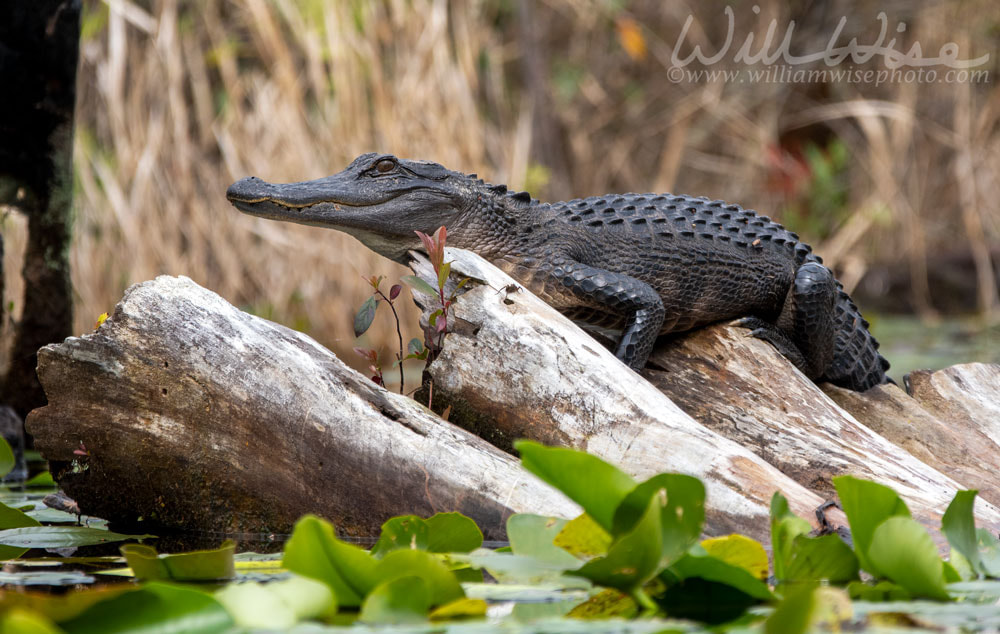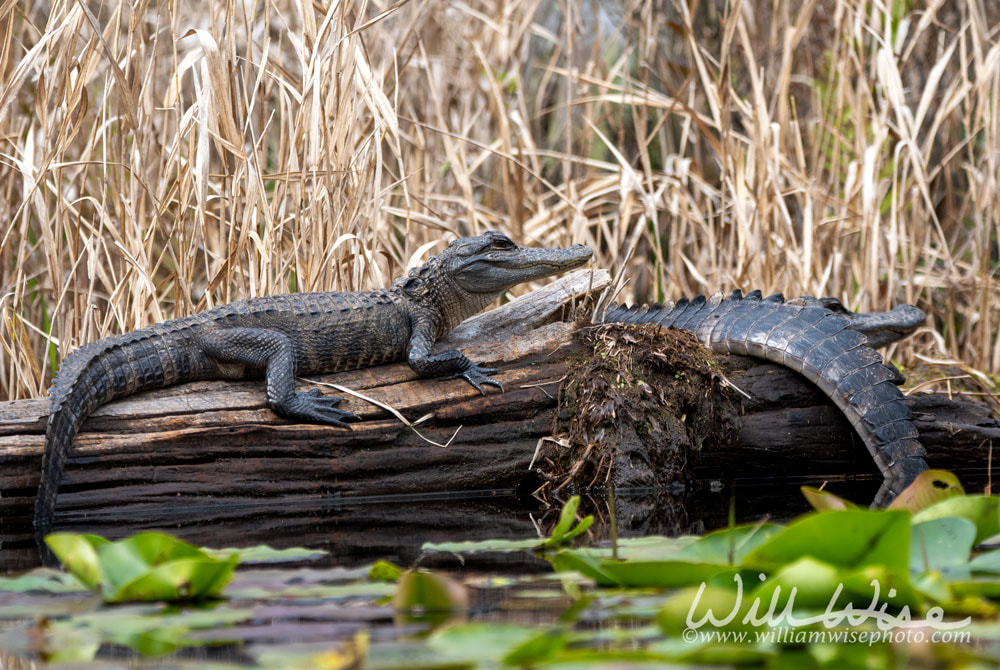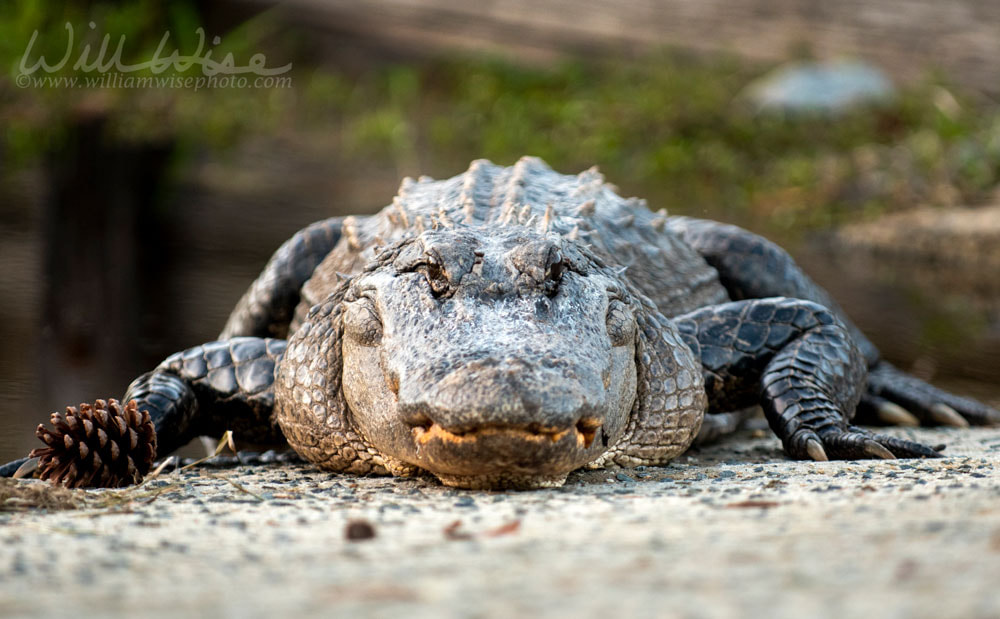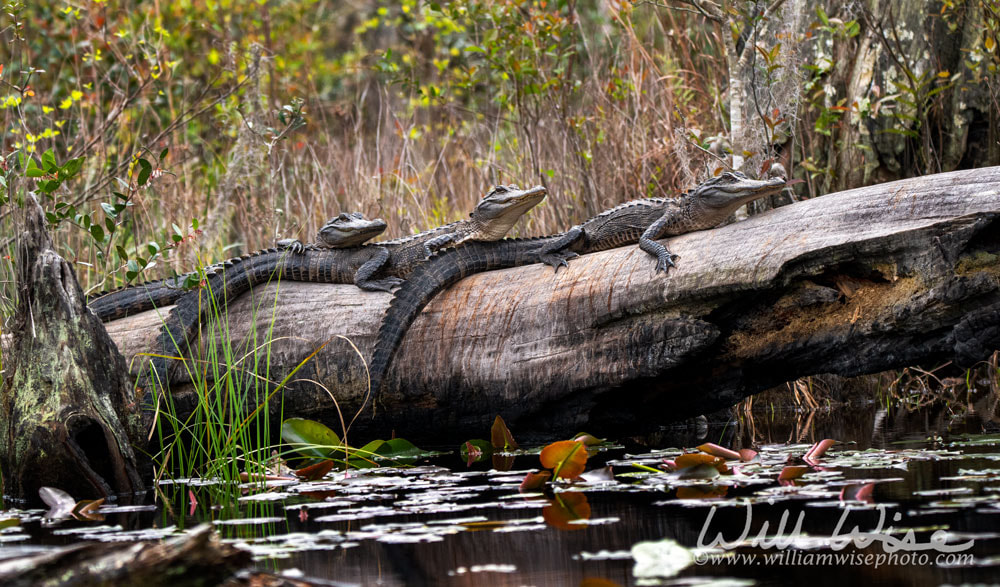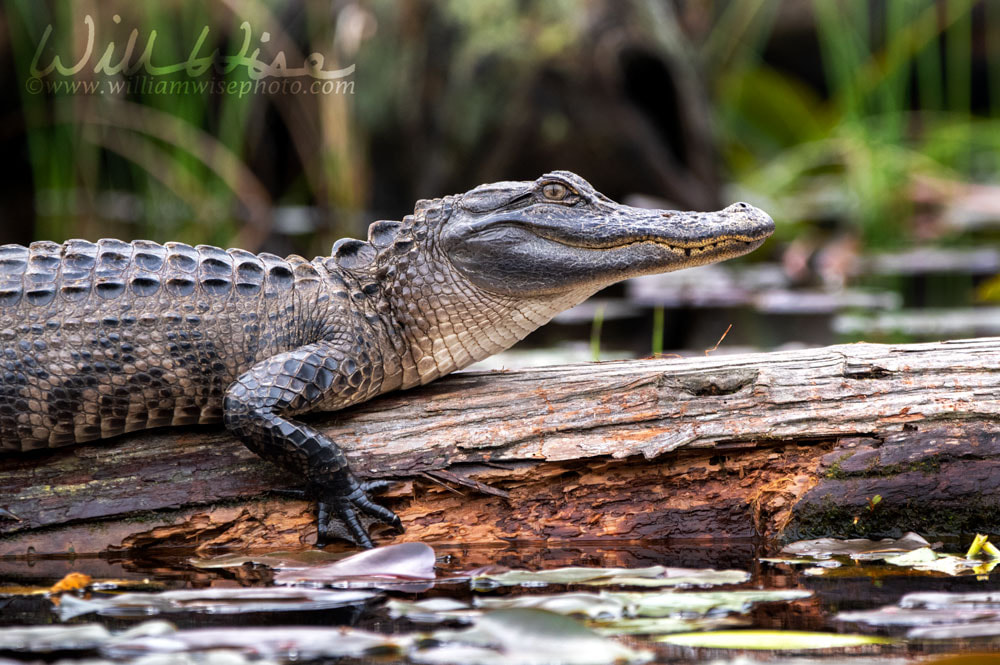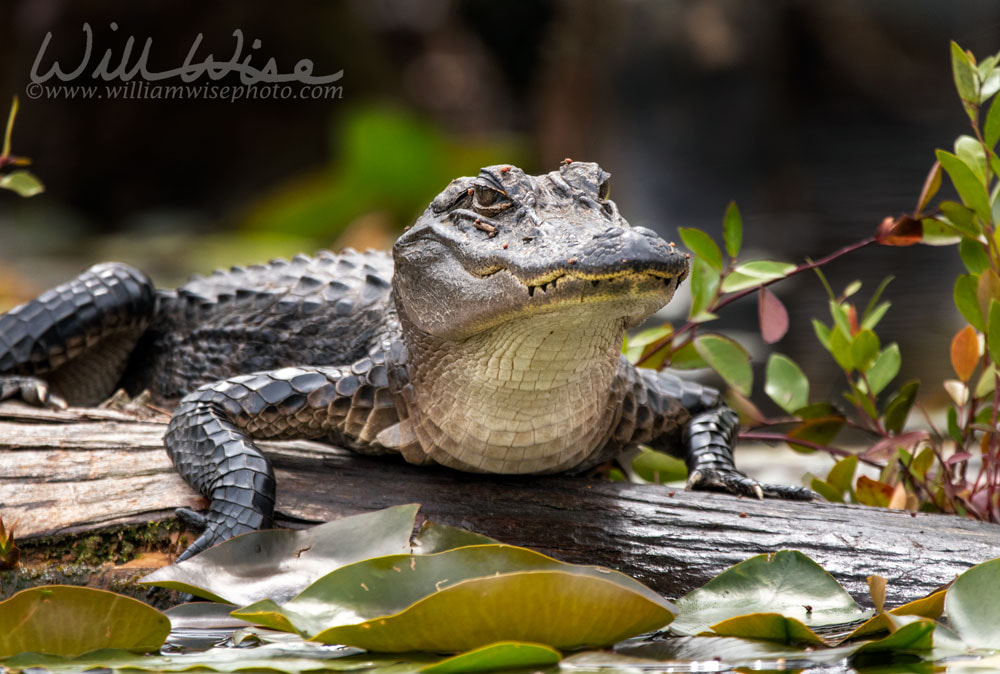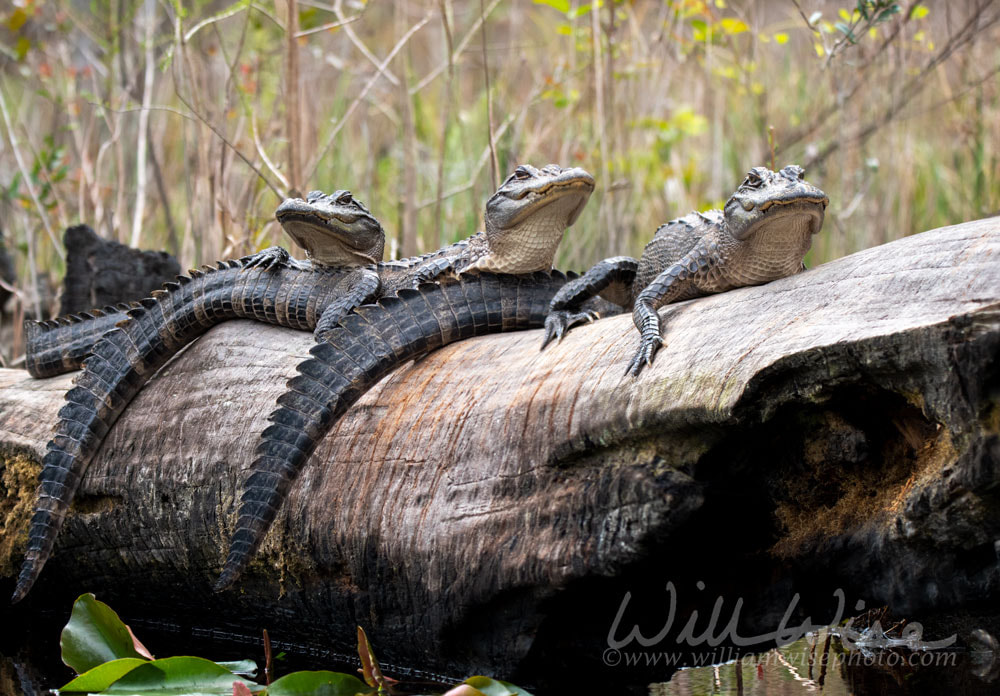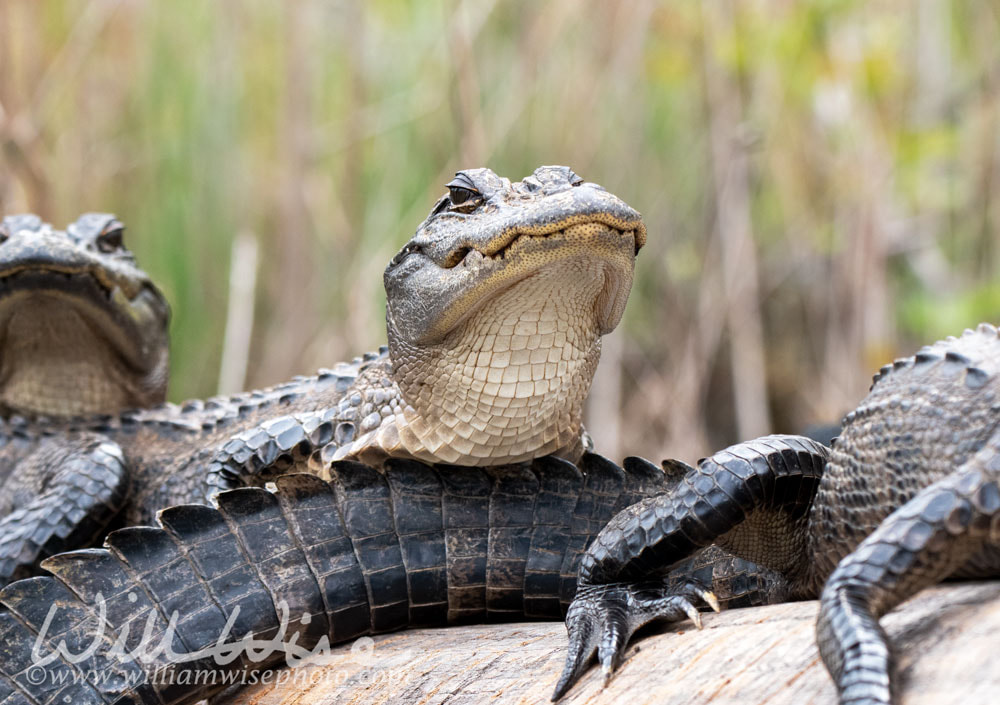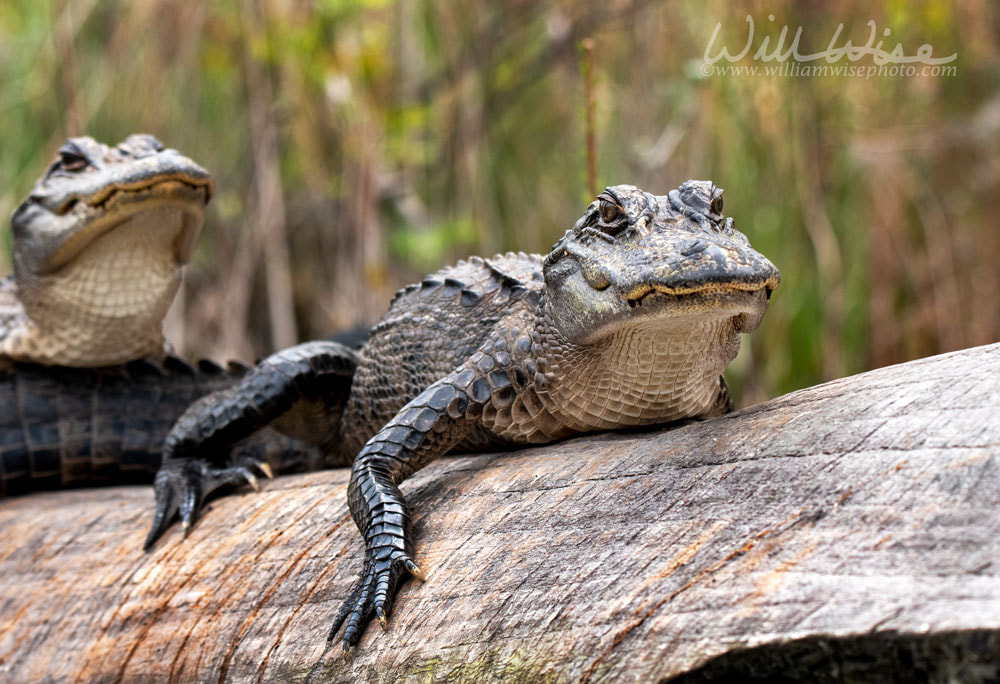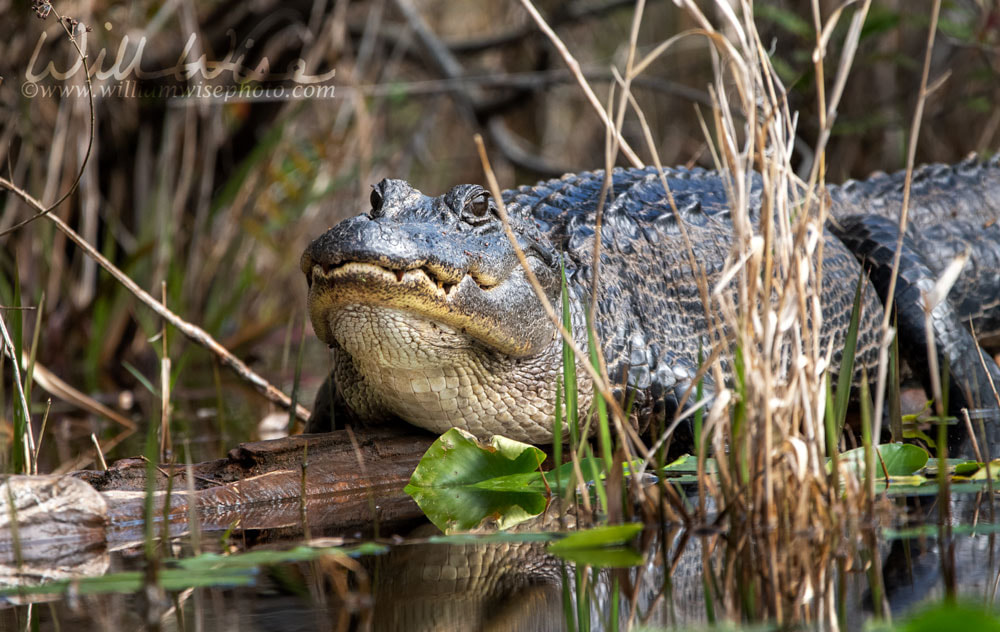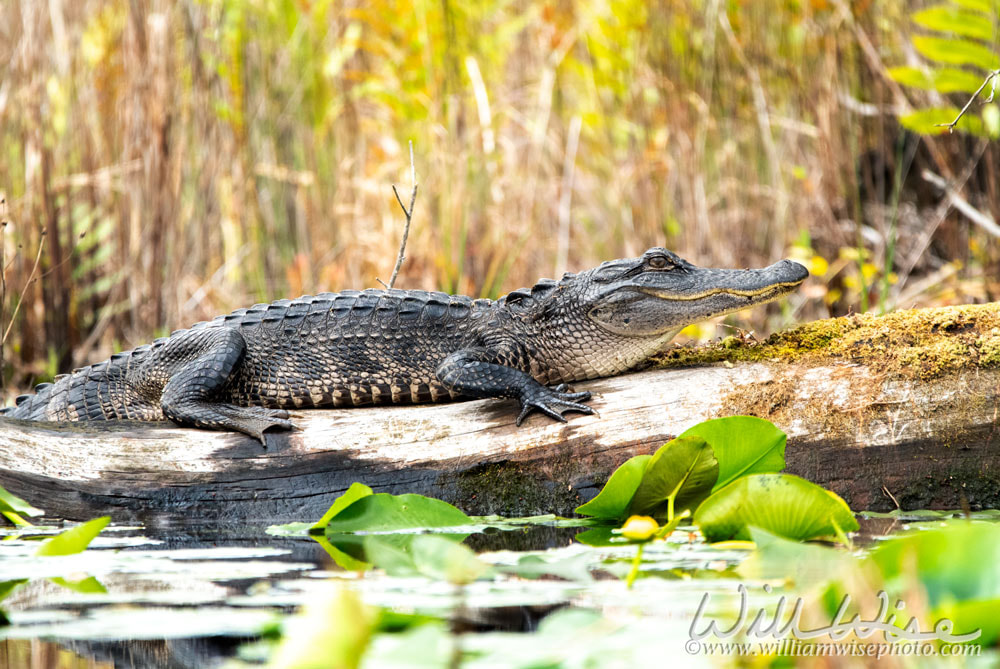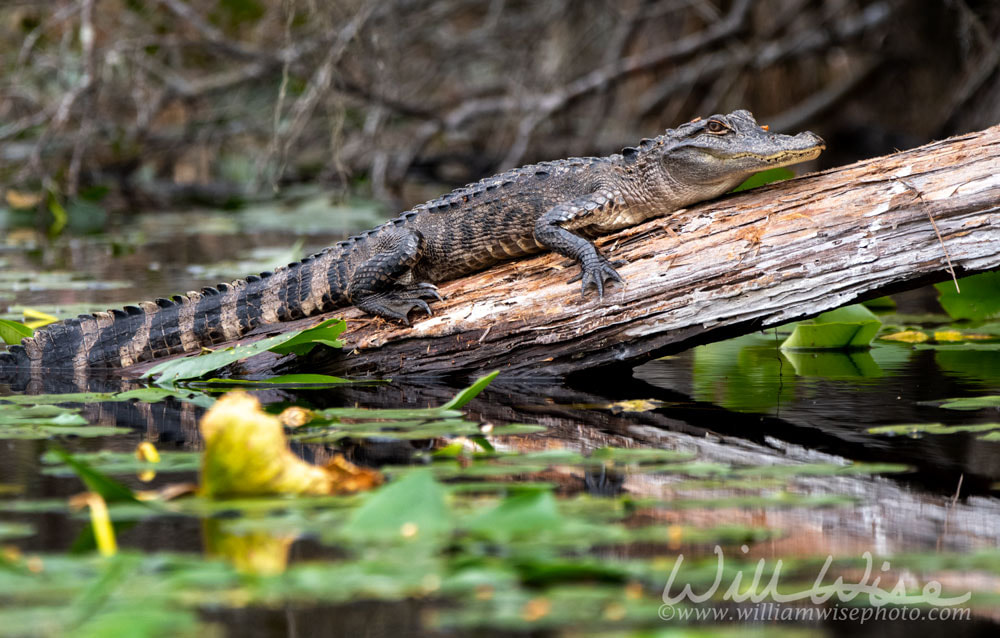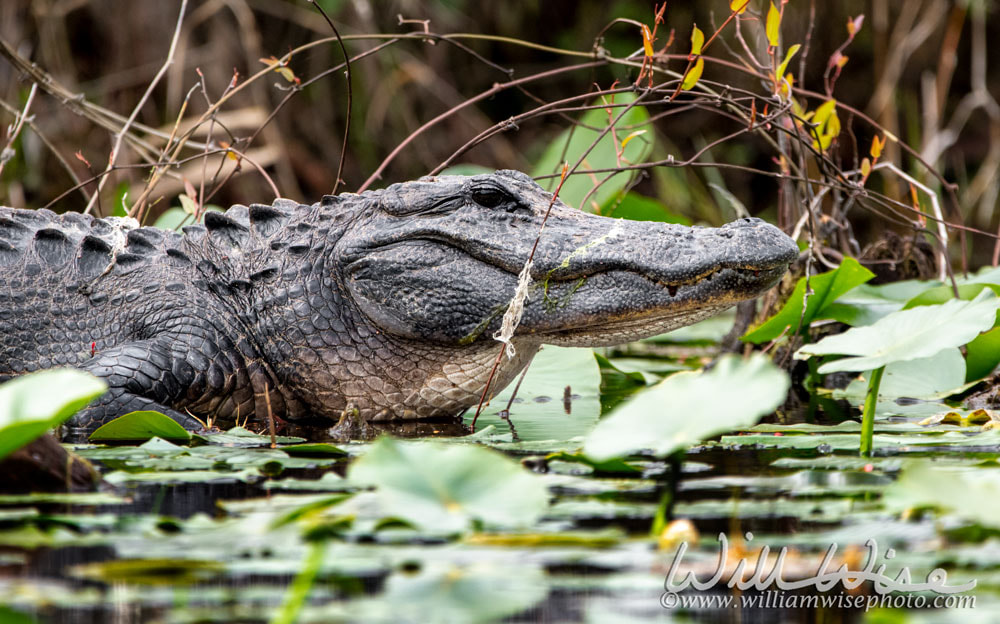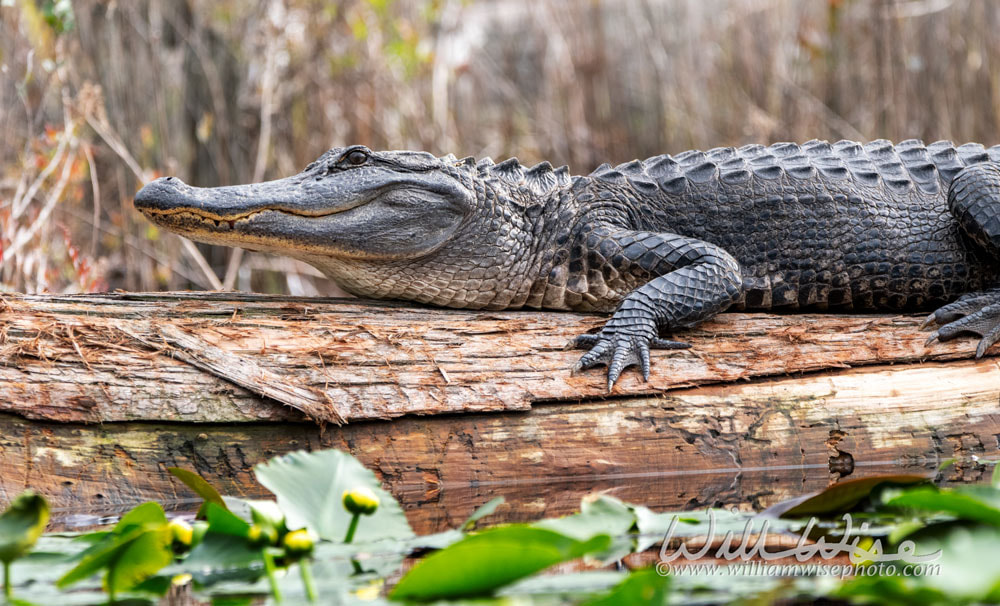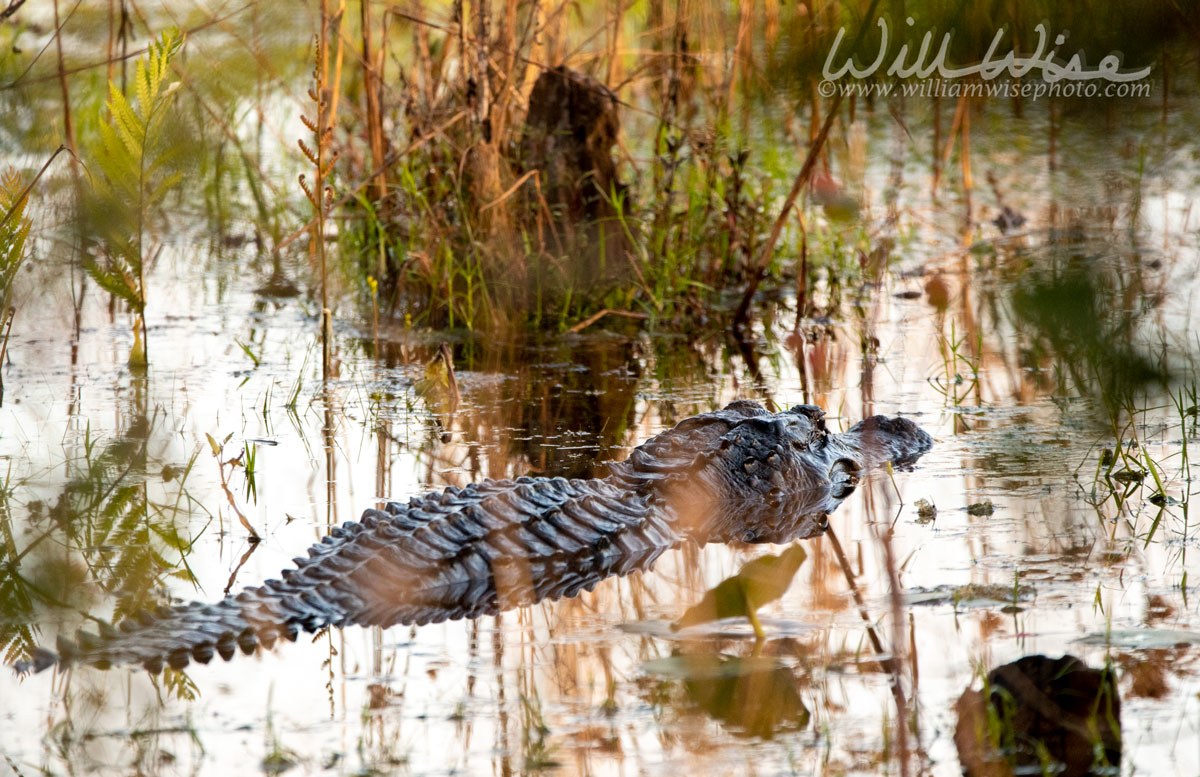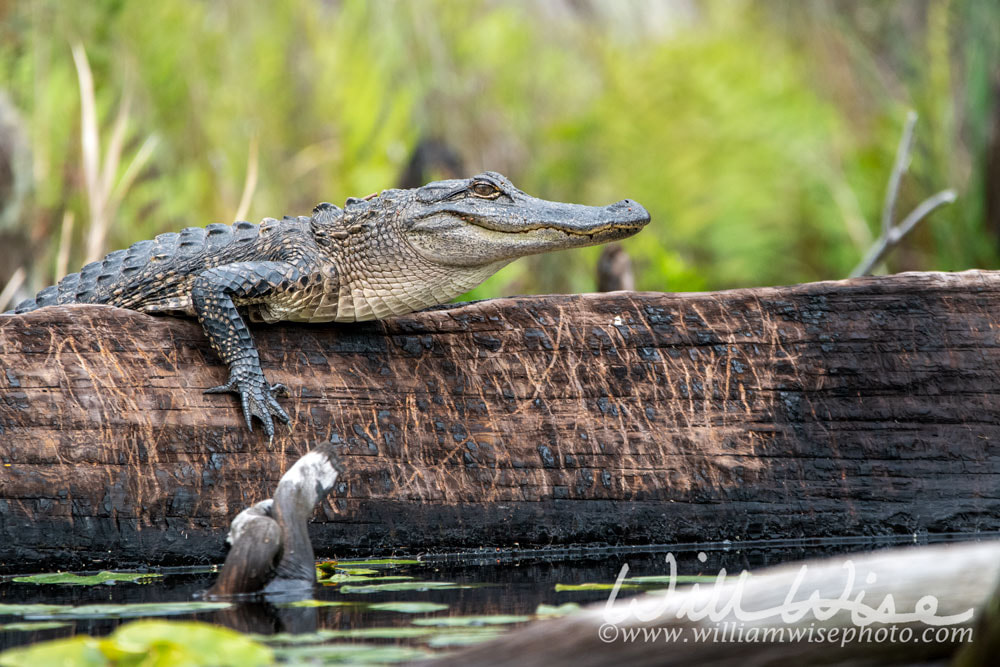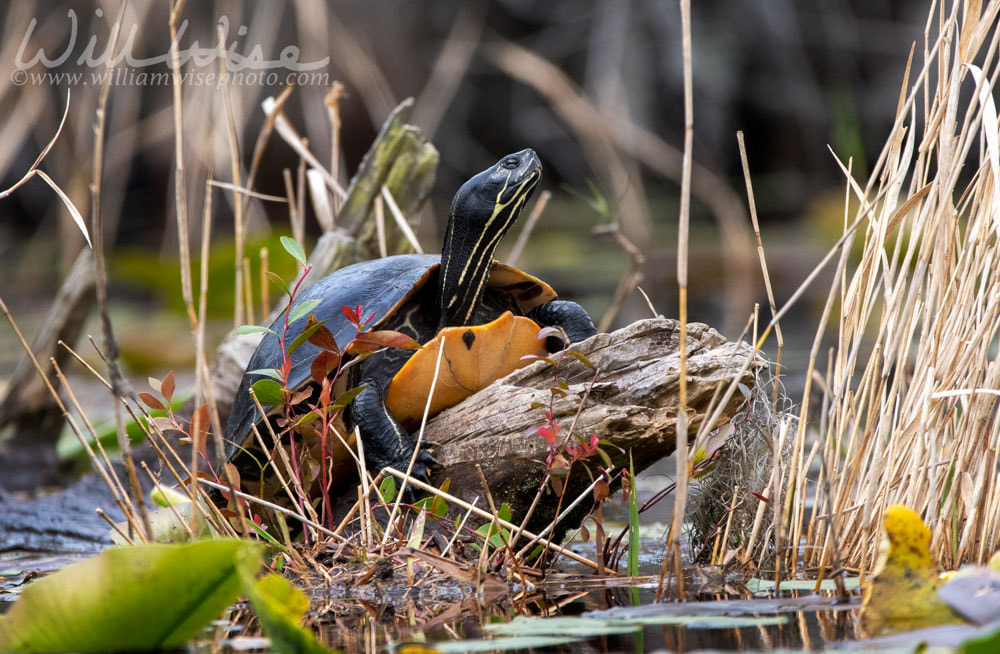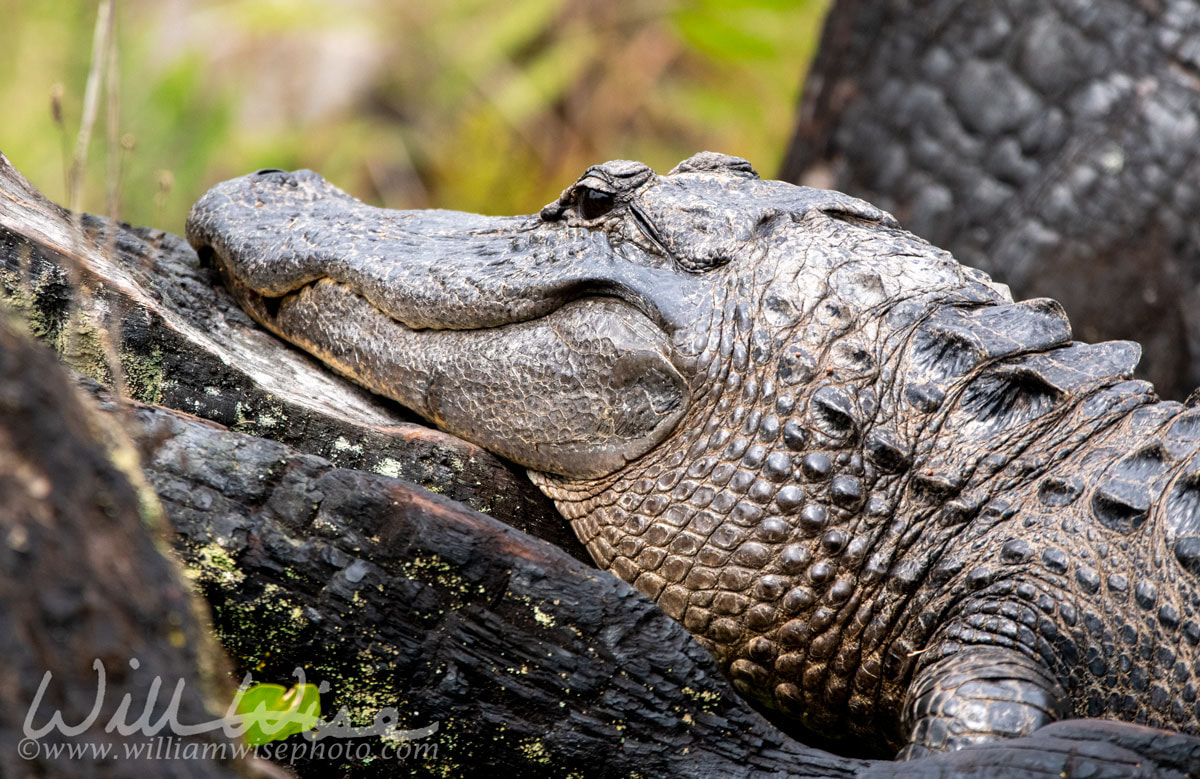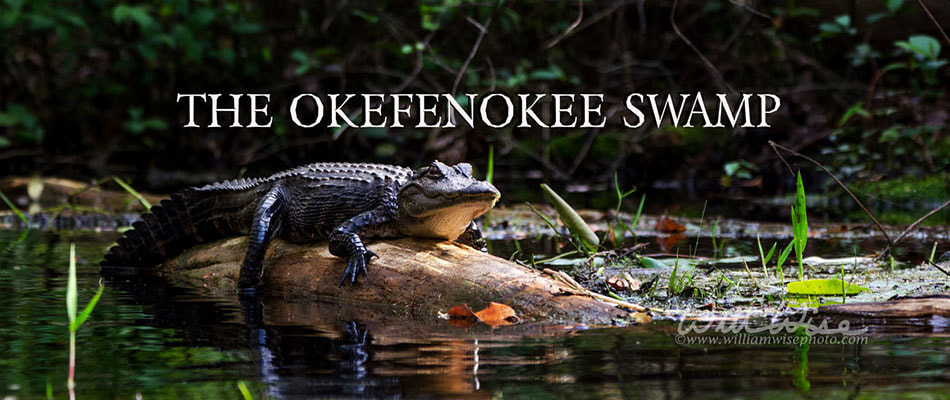 Okefenokee Photography by William Wise. A nature photo journal exploration of Georgia's Okefenokee Swamp, the Land of Trembling Earth, one of the largest blackwater swamps in North America. The alligators, birds, snakes and wildlife of Okefenokee National Wildlife Refuge and Stephen C Foster State Park. -- "What a wildly wonderful world, God! You made it all, with Wisdom at Your side, made earth overflow with your wonderful creations." Psalms 104 The Message While there are reportedly 15 turtles in the Okefenokee Swamp regions, my most commonly photographed species is the Coastal Plain Cooter (Pseudemys concinna ssp. floridana). While abundant in the Okefenokee Swamp, they are found all along the coastal plain (hence the common name) from southeastern Virginia, south into Florida, and west into Alabama.
They can be quite large (up to a 13-inch carapace length) and would be quite conspicuous if they didn’t dive off their basking spots long before your canoe approaches. As we paddle along, if I keep my binoculars trained ahead, I typically see these cooters sliding into the water left and right all along the Okefenokee canoe trails. On our springtime Okefenokee trips, one or two will occasionally remain out in the warm sun long enough for a closer photograph being reluctant to dive back into the cool water.
0 Comments
 Okefenokee Photography by William Wise. A nature photo journal exploration of Georgia's Okefenokee Swamp, the Land of Trembling Earth, one of the largest blackwater swamps in North America. The alligators, birds, snakes and wildlife of Okefenokee National Wildlife Refuge and Stephen C Foster State Park. -- "What a wildly wonderful world, God! You made it all, with Wisdom at Your side, made earth overflow with your wonderful creations." Psalms 104 The Message In the spring the Okefenokee Swamp shrubbery is decorated with delicate rows of tiny pink and white bells. These small flowers are of the Lyonia bush. Although they look and smell like a sweet Valentine’s Day treat, they haven’t always been thought of so fondly, as revealed by its other common names: staggerbush, fetterbush, and hurrah bush. Fetterbush grows thickly and is often entangled with other shrubs and vines, such as the well-armed greenbrier. Being so thick, it fetters the legs of anyone attempting cross the swamp on foot. Fetters were prisoners’ iron shackles in a less politically correct age. In fact, when his weakness was exploited, the Biblical strongman Samson was “bound in fetters of brass to grind in the prison house.” Lyonia’s other common name, Hurrah bush, comes from the exclamatory shout for joy made by the swamp adventurer that finally makes it through the thickets and staggers into a clearing. There are several narrow canoe trails lined with thickets that my daughter despises paddling through. For it seems that not only is Fetterbush tipped with cute little flowers, but also with creepy little spiders waiting to jump into your kayak! Sources:  Okefenokee Photography by William Wise. A nature photo journal exploration of Georgia's Okefenokee Swamp, the Land of Trembling Earth, one of the largest blackwater swamps in North America. The alligators, birds, snakes and wildlife of Okefenokee National Wildlife Refuge and Stephen C Foster State Park. -- "What a wildly wonderful world, God! You made it all, with Wisdom at Your side, made earth overflow with your wonderful creations." Psalms 104 The Message Excerpt from Francis Harper's Mammals of the Okefinokee Swamp, published March 1927:

Okefenokee Photography by William Wise. A nature photo journal exploration of Georgia's Okefenokee Swamp, the Land of Trembling Earth, one of the largest blackwater swamps in North America. The alligators, birds, snakes and wildlife of Okefenokee National Wildlife Refuge and Stephen C Foster State Park. -- "What a wildly wonderful world, God! You made it all, with Wisdom at Your side, made earth overflow with your wonderful creations." Psalms 104 The Message
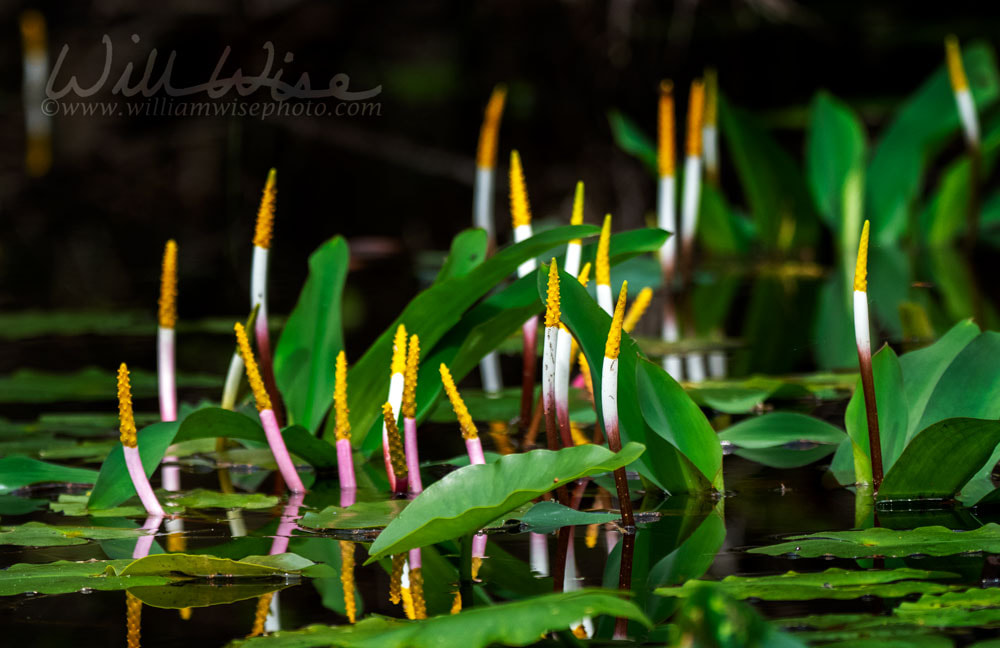
Golden Club Orontium aquaticum is a flowering spike of color that blooms above the tannin black water of the Okefenokee Swamp. A pink and white stem with gold flower spikes, like golden clubs, and dark green leaves that are waxy and water repellent, giving it the name Never-wet. It is a floating arum endemic to the eastern United States. Okefenokee National Wildlife Refuge, Georgia. March 2020.
In my earlier days, I never was much of a plant enthusiast. In fact, I primarily overlooked vegetation, or looked through it to spot snakes and birds! But as one paddles the black waters of the Okefenokee Swamp you can’t ignore the colorful spikes of gold, white and pink that rise above the lily pads on the Middle Fork of the Suwannee River (Red Trail), and other canals throughout the swamp.
Golden Club (Orontium aquaticum) is a flowering spike of color that blooms above the tannin black water of the Okefenokee Swamp. A pink and white stem with gold flower spikes, like "golden clubs", and dark green leaves that are waxy and water repellent, giving it the name Never-wet. It is a floating arum endemic to the eastern United States. At times, they bloom in small patches here and there. But there is nothing more beautiful that a wide patch of colorful Never-wet in the darker areas of the swamp. Vibrant colors that capture the attention of the traveler.  Okefenokee Photography by William Wise. A nature photo journal exploration of Georgia's Okefenokee Swamp, the Land of Trembling Earth, one of the largest blackwater swamps in North America. The alligators, birds, snakes and wildlife of Okefenokee National Wildlife Refuge and Stephen C Foster State Park. -- "What a wildly wonderful world, God! You made it all, with Wisdom at Your side, made earth overflow with your wonderful creations." Psalms 104 The Message Okefenokee Swamp paddlers owe much to the federal and state park employees that keep the National Wildlife Refuges canoe and kayak trails clear, maintained and well-marked. When one visits today, direction signs label and point to Billy’s Lake, Minnie’s Lake, Big Water, Canal Run and more. Since cell phone and GPS signals can be unreliable in the heart of the swamp, the regular mile markers are a true blessing as well. But it wasn’t always that way! Hamp Mizell writes in 1926 of his father: “It was in the early winter of 1874 that my father found Chase Prairie. He had determined to try a boat in an effort to get through the Swamp instead of the old way of wading and jumping from one clump of bushes to another, all the time bogging from knee deep to armpits, which was the old way of traveling in the great Swamp. So unless you’re an Okefenokee expert, it would be a nice thing to thank the park employees if you encounter them on your journey, or during your stay in the wonderful Okefenokee National Wildlife Refuge!  Okefenokee Photography by William Wise. A nature photo journal exploration of Georgia's Okefenokee Swamp, the Land of Trembling Earth, one of the largest blackwater swamps in North America. The alligators, birds, snakes and wildlife of Okefenokee National Wildlife Refuge and Stephen C Foster State Park. -- "What a wildly wonderful world, God! You made it all, with Wisdom at Your side, made earth overflow with your wonderful creations." Psalms 104 The Message The Okefenokee Swamp presents the adventurer an impressive number of alligator encounters. Large gators often line the edges of Okefenokee’s lakes, like Billy’s Lake, Minnie’s Lake and Big Water. These gators rarely pose a threat to humans, and more often than not they dive into the water before you even approach too closely. But at times they will allow some real close-up shots. (The alligator in this series of photos was very reluctant to leave its warm sunning log.) In early spring, when the waters are cool and the sun is warm, they may stay upon their basking spots and allow some really close approaches. But don’t mistake their tolerance for tameness. Even though the gators look huggable, they are not pets and the Okefenokee is not a petting zoo! In my many visits I have had no real concerning close-calls. Only once, while photographing a pod of babies, did a female alligator approach rather than evade. Female alligators will protect their young and nests, so it is best to stay clear of an angry momma.  Okefenokee Photography by William Wise. A nature photo journal exploration of Georgia's Okefenokee Swamp, the Land of Trembling Earth, one of the largest blackwater swamps in North America. The alligators, birds, snakes and wildlife of Okefenokee National Wildlife Refuge and Stephen C Foster State Park. -- "What a wildly wonderful world, God! You made it all, with Wisdom at Your side, made earth overflow with your wonderful creations." Psalms 104 The Message Unless they are tagged or have some unique scars, American Alligators are quite hard to tell apart. I’m sure there are subtle differences in size and features that could be identified if one spent some time comparing photographs. But for the most part, I can only suspect some of the alligators I’ve encountered multiple Okefenokee trips are the same as on prior adventures. But when one is recognized, it feels like meeting an old friend!
On our trip this March, we came across one of those old friends that I know we have seen before. As soon as I saw it, I immediately remembered the amputated foot and missing lip. I had even wrote a blog called Gator Battles about this uniquely scarred gator in March 2019. In fact, looking at the one-year-old photo, I think it may even be perched on the same log!  Okefenokee Photography by William Wise. A nature photo journal exploration of Georgia's Okefenokee Swamp, the Land of Trembling Earth, one of the largest blackwater swamps in North America. The alligators, birds, snakes and wildlife of Okefenokee National Wildlife Refuge and Stephen C Foster State Park. -- "What a wildly wonderful world, God! You made it all, with Wisdom at Your side, made earth overflow with your wonderful creations." Psalms 104 The Message While paddling through the Okefenokee Swamp in Georgia, I came upon an awesome scene. Multiple juvenile alligators were stacked upon logs and lily pads in a small cove on Minnie’s Lake. My eyes took in the whole scene and I was overwhelmed with delight and wonder. But my joy was replaced with a bit of sadness because I knew the limitations of photography would hinder capturing the scene. One young alligator lay close to my canoe, while three gators were stacked on a fallen cypress further back in the scene. This was a problem, for, in photography terms, they were in different focal planes. If I focused on the three alligators up on the log, the one near me would be out of focus. And if I trained my lens upon the gator close by my canoe, the triplets on the log would be blurred. So my little brain ticked away and I decide to take multiple shots and see if I could “focus stack” them later. One source states, “Focus stacking is a digital image processing technique which combines multiple images taken at different focus distances to give a resulting image with a greater depth of field (DOF) than any of the individual source images.” In simpler terms, you take one photo with the foreground in focus and combine it with another photo with the background in focus. The two (or more) photos are “stacked” in layers in the processing software and a final image is produced that has the entire scene in focus. Ideally, you want to have the camera secured without movement on a tri-pod so each photograph is identical in composition. I was in a moving canoe, and had to do the best I could. Although it was more of a challenge to combine the photos, it worked out fairly well with my alligator scene. Still, a photograph just can’t replace the immensity of the moment… alligators on the left, alligators on the right, a breeze blowing through the Spanish Moss, the buzz of dragonflies, and the gentle current of the Suwannee River as it flows through the Okefenokee Swamp. You just have to be there!
 Okefenokee Photography by William Wise. A nature photo journal exploration of Georgia's Okefenokee Swamp, the Land of Trembling Earth, one of the largest blackwater swamps in North America. The alligators, birds, snakes and wildlife of Okefenokee National Wildlife Refuge and Stephen C Foster State Park. -- "What a wildly wonderful world, God! You made it all, with Wisdom at Your side, made earth overflow with your wonderful creations." Psalms 104 The Message “Dad, can we go back to Minnie’s Lake today,” my daughter asked. She always loves paddling through the scenic, narrow channel of the Red Trail looking for baby alligators along the way. And then when nearing Minnie’s Lake, the scene opens up as the trees retreat the shrubs back off. There are typically gators galore... and don’t forget the rest dock and latrine! Minnie’s Lake is under 4 miles from the Stephen C Foster boat launch. If you’re an experienced paddler, this is no big deal at all. But even if a 7.5 mile round-trip paddle seems like a daunting task, it is well worth the toil. Because of the current on the Suwannee River, the trip up to Minnie’s lake is a bit harder. If you stop paddling, you may drift downstream. But push through and you’ll have a chance to rest at the platform. The paddle home is always leisurely, allowing more opportunity to enjoy the Swamp scenes. There is always a mixture of sizes of alligators on Minnie's Lake. The edges of the lake are lined with Spatterdock lily pads and floating masses of “gator taters” which provide perfect basking spots for even the larger alligators. They seem quite accustomed to visitors on Minnie’s Lake and will often hold their positions allowing for some great photography.  Okefenokee Photography by William Wise. A nature photo journal exploration of Georgia's Okefenokee Swamp, the Land of Trembling Earth, one of the largest blackwater swamps in North America. The alligators, birds, snakes and wildlife of Okefenokee National Wildlife Refuge and Stephen C Foster State Park. -- "What a wildly wonderful world, God! You made it all, with Wisdom at Your side, made earth overflow with your wonderful creations." Psalms 104 The Message Any visitor to the Stephen C Foster Georgia State Park campground in the heart of the Okefenokee Swamp has met "Sophie". She is the resident gator that lives, patrols and fills the boat launch area with babies every year. Sophie can often be seen laying in the grass near the canoes, or occasionally up on the boat ramp. On most of my visits, Sophie has been the only gator in the boat ramp area. But on this trip, her suitor, "Tank" was hanging around, undoubtedly awaiting the beginning of breeding season!

Okefenokee Photography by William Wise. A nature photo journal exploration of Georgia's Okefenokee Swamp, the Land of Trembling Earth, one of the largest blackwater swamps in North America. The alligators, birds, snakes and wildlife of Okefenokee National Wildlife Refuge and Stephen C Foster State Park. -- "What a wildly wonderful world, God! You made it all, with Wisdom at Your side, made earth overflow with your wonderful creations." Psalms 104 The Message
At the north end of Minnie’s Lake on the Middle Fork of the Suwanee River in the Okefenokee, we paddled into a cove of Spatterdock and downed cypress that held an inspiring spectacle: no less than six or seven young alligators congregated in a small area. The center of attention were three that were perfectly perched upon a large log, looking like triplet twins.
We slowly rowed into their midst and they surprisingly sat quite still. What a feeling to be surrounded left and right by these young gators. There was no way to capture the feeling and scene on camera, nor even on film! I imagine they were all of one pod, being nearly identical in size and length. I would even like to think they were the same group we saw as babies in 2015 a couple of miles south of this spot.
We savored the moment, looked at each one in the eye, watched as their throats pulsated with each breath, until they one by one, began to jump off into the waters. In fact, the moment was so special, it deserved an Okefenokee selfie!
 Okefenokee Photography by William Wise. A nature photo journal exploration of Georgia's Okefenokee Swamp, the Land of Trembling Earth, one of the largest blackwater swamps in North America. The alligators, birds, snakes and wildlife of Okefenokee National Wildlife Refuge and Stephen C Foster State Park. -- "What a wildly wonderful world, God! You made it all, with Wisdom at Your side, made earth overflow with your wonderful creations." Psalms 104 The Message “I have always understood,” said Bilbo the Hobbit in a frightened squeak, “that dragons were softer underneath…” The dragon Smaug stopped short in his boasting. “Your information is antiquated,” he snapped. “I am armoured above and below with iron scales and hard gems. No blade can pierce me… My armour is like tenfold shields, my teeth are swords, my claws spears, the shock of my tail a thunderbolt…!” 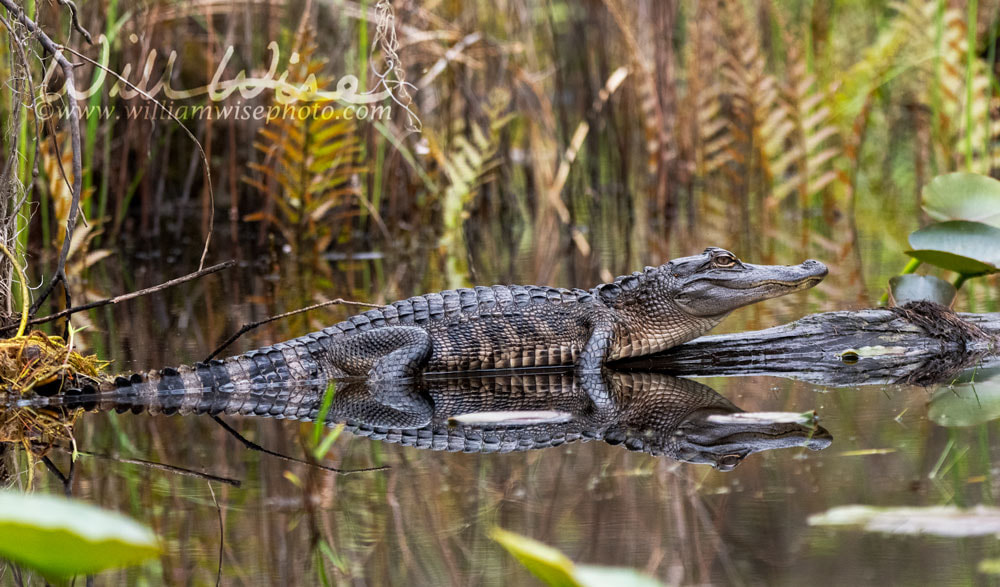 An alligator’s body is covered by a dermal exoskeleton of massive, thick, tough scales and scutes which protect it like armor. Some are touch sensitive integumentary sensory organs for sensing and locating prey in dark blackwater swamps. Okefenokee Swamp National Wildlife Refuge, Georgia. March 10, 2020. Truly, the American Alligator is a living dragon. In an entry aptly titled, Crocodilian Armor, Wikipedia states, “The epidermal exoskeleton of the alligator consists of oblong horny scales, arranged in transverse rows. The dermal exoskeleton consists of bony scutes.” Massive scutes along its back, and smaller scales along its sides, arms and hips. A close-up look reveals a mesmerizing puzzle-like pattern without gap or chink; all laid in order, above and below… an impressively armored creature! Its armor is not just as a shield during battles with his own kind, nor just for protection from the hardness of the swamp environment, but to prevent water loss and dehydration in his sultry tropical climate. Although the armor appears thick and tough, parts of an alligator’s body are quite sensitive – even more than a human fingertip. An asknature.org article says, "The touch-sensitive organs are called integumentary sensory organs. Thousands of these sensory organs cover the alligator’s face. They are especially dense around the teeth, inside the mouth, and at the tip of the snout. Researchers hypothesize that these extremely touch-sensitive areas around the mouth help the alligator locate, capture, and examine prey even when visual and sound cues are absent." 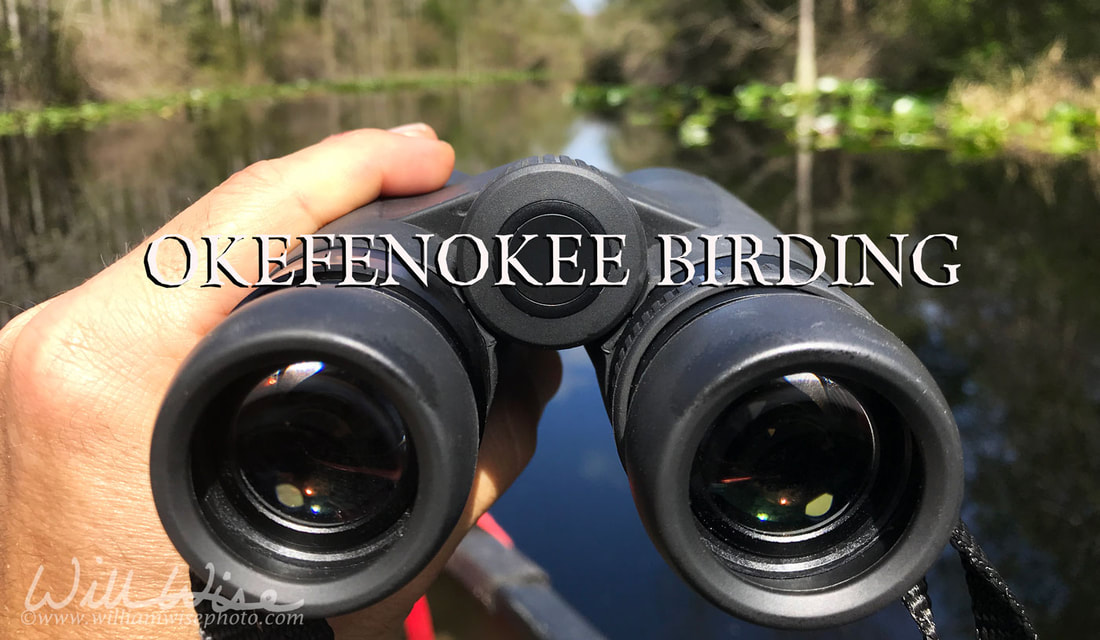 Okefenokee Photography by William Wise. A nature photo journal exploration of Georgia's Okefenokee Swamp, the Land of Trembling Earth, one of the largest blackwater swamps in North America. The alligators, birds, snakes and wildlife of Okefenokee National Wildlife Refuge and Stephen C Foster State Park. -- "What a wildly wonderful world, God! You made it all, with Wisdom at Your side, made earth overflow with your wonderful creations." Psalms 104 The Message Because it is low swamp land, there aren't any long hiking trails in the Stephen C Foster State Park in the Okefenokee. However, the park has done a great job maximizing the shorter trails. Every evening after returning off the water, and every morning waiting on my daughter to wake up, I walk the Trembling Earth Nature Trail, the Upland Trail and the Campground Trail for some birding.
 Okefenokee Photography by William Wise. A nature photo journal exploration of Georgia's Okefenokee Swamp, the Land of Trembling Earth, one of the largest blackwater swamps in North America. The alligators, birds, snakes and wildlife of Okefenokee National Wildlife Refuge and Stephen C Foster State Park. -- "What a wildly wonderful world, God! You made it all, with Wisdom at Your side, made earth overflow with your wonderful creations." Psalms 104 The Message Internet rumor has it that the alligator received its name from the Spanish explorers that claimed Florida in the 1500’s. If true, I’m sure that el legarto didn’t simply mean a lizard, but THE Lizard! For the impressive alligator is no mere squamate, but on the order of a greater magnitude: Crocodilia!
The order Crocodilia are large, predatory reptiles. They are primarily carnivorous and feast upon fish, crustaceans, birds, mammals and even other reptiles. While they are quite imposing in appearance, and some crocodilians have attacked humans (the largest number of attacks comes from the Nile crocodile), the American Alligator is rarely a threat to people. (source: https://en.wikipedia.org/wiki/Crocodilia) According to a Georgia Department of Natural Resources publication, “the opportunity for humans to experience any of the alligator’s weapons first hand will come only to those who attempt to capture one. Under natural conditions, alligators are usually shy, retiring creatures that generally mind their own business, which does not include promoting encounters with humans.” Still, el legarto is no mere lizard!  Okefenokee Photography by William Wise. A nature photo journal exploration of Georgia's Okefenokee Swamp, the Land of Trembling Earth, one of the largest blackwater swamps in North America. The alligators, birds, snakes and wildlife of Okefenokee National Wildlife Refuge and Stephen C Foster State Park. -- "What a wildly wonderful world, God! You made it all, with Wisdom at Your side, made earth overflow with your wonderful creations." Psalms 104 The Message A day paddling up the Middle Fork (red trail) of the Suwannee River in the Okefenokee Swamp, Georgia. |
Categories
All
Archives
November 2024
|
|
All content is ©williamwisephoto.com. Please don't steal images. My images are available at dreamstime.com. Stock sales go into the shelter photography program.
|
In December 1993 I came to know the Designer and Creator of this wonderful planet and its creatures: Jesus Christ.
|
Donations help support the animal shelter adoption photography equipment and adoption website hosting and domain fees. Thanks for your support!
|
